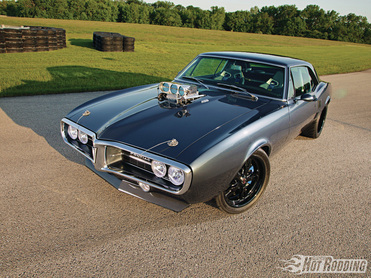 THM 700R4 - 4L60 Transmission
THM 700R4 - 4L60 Transmission I will discuss some of the principal areas for high performance modifications. Although there will be discussion on hydraulic controls, the various high performance, after market valve body kits, work very well whether it's for furnishing very short and firm tire chirping shifts in an IROC-Z , or ferocious shifts in a drag strip 11.52 et runner. Valve body kits offer convenience, since most are packaged with parts and data to modify main line pressure, shift scheduling, shift feel and firmness, detent downshifts etc. The parts and technical information also coordinate with the separator plate orifice sizes, 2-4 servo pistons, accumulators etc. For all installations, we suggest that you follow the instructions carefully. Write down every step that you perform. This way, if a calibration change is needed, you will at least have a reference point.
Okay, let's build this 700 to be a winner! You, the transmission, and whomever the customer is will be a winner too!
Intermediate Servo Piston
Accumulator Valve
Main Line Pressure & Boost Systems *(really important!)*
IMPORTANT TECH NOTE: On most high-rev applications, an upshift to second can occur even though the selector is in manual one. Installing the #8648959 .297 inch setup will keep the unit in first with the selector in manual one right up to floating the valves, however, at moderately higher speed, the unit will go into first if the selector is pulled into manual one after an upshift to second or third gear.
Be careful and thoughtfull here. Given the right road conditions, this can cause loss of vehicle control. Be sure to caution your customer! Having him or her sign a waiver or disclaimer ont he repair order might be a good idea. Installing a heavier pressure regulator valve spring only and ignoring these two boost systems could lead to sup standard performacne and many hours of rework so why not Fix It Right The First Time!
3-4 Clutch Pack
One option is to install standard thickness high capacity or high energy friction plates readily available from your parts distributor. These friction plates use use a special composition of friction paper for heavy duty and performance applications. Another option is to install thinner friction and steel plates-which are available through the aftermarket-allowing you to install as many as eight or nine friction's. When the eight or nine friction pack applies, the energy of the apply is distributed over more surface area therefore the clutch pack is able to hold much more torque load as opposed to the original capacity. In addition to increasing the torque holding power it also adds much more resiliency and an accumulative value to the clutch pack.
With an eight or nine friction pack installed, you can increase the third feed orifice to as much as .180 inch without experiencing a cut loose-providing that the pressure rise control system and everything else in the unit is functioning properly. If the third feed is between .093 inch - .110 inch and you desire additional high throttle firmness, remove the 2-4 servo assembly, and replace the original band release spring with a stock THM 400 intermediate band spring number 8623489.
When using the eight or nine clutch pack, we suggest using the red friction plates with either the dull or Kolene steel plates. If you purchase these plates separately instead of in kit form, ask your distributor for the four page instruction sheet which contains valuable technical information as well as stack-up procedures.
Odds And Ends
-GEARS Magazine May 1997


 RSS Feed
RSS Feed